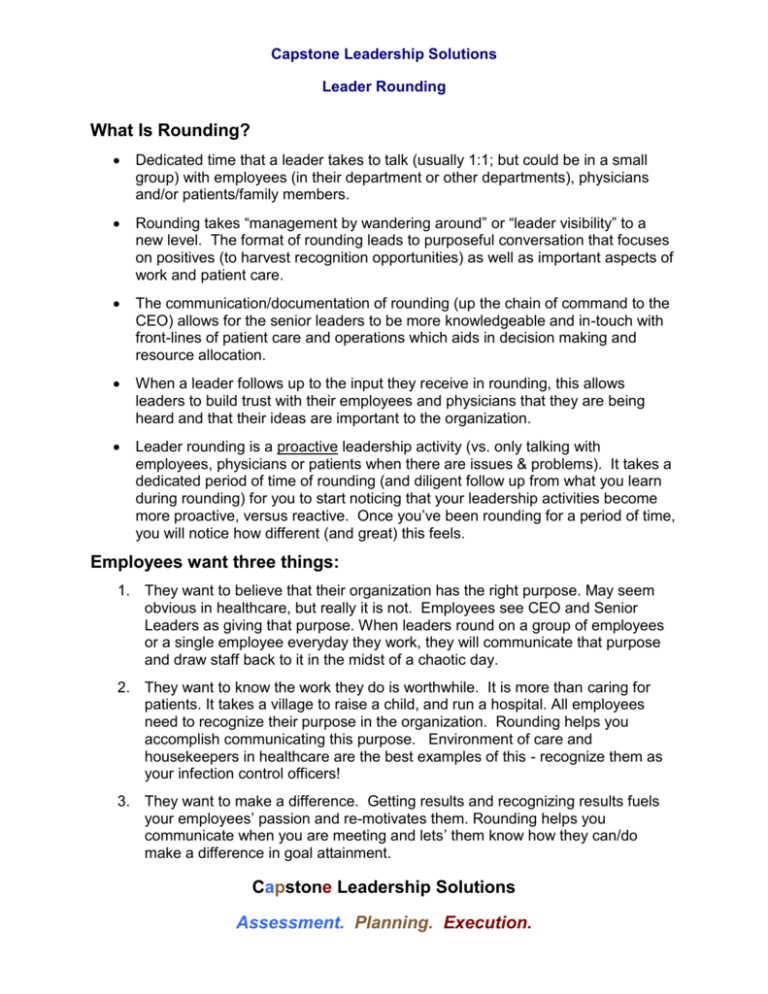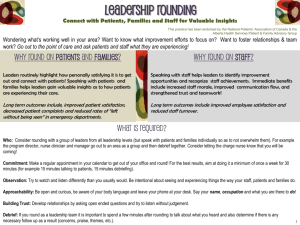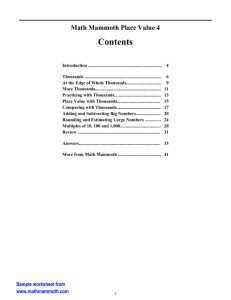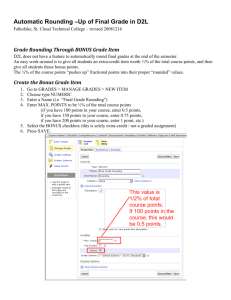Capstone Leader Rounding
advertisement

Capstone Leadership Solutions Leader Rounding What Is Rounding? Dedicated time that a leader takes to talk (usually 1:1; but could be in a small group) with employees (in their department or other departments), physicians and/or patients/family members. Rounding takes “management by wandering around” or “leader visibility” to a new level. The format of rounding leads to purposeful conversation that focuses on positives (to harvest recognition opportunities) as well as important aspects of work and patient care. The communication/documentation of rounding (up the chain of command to the CEO) allows for the senior leaders to be more knowledgeable and in-touch with front-lines of patient care and operations which aids in decision making and resource allocation. When a leader follows up to the input they receive in rounding, this allows leaders to build trust with their employees and physicians that they are being heard and that their ideas are important to the organization. Leader rounding is a proactive leadership activity (vs. only talking with employees, physicians or patients when there are issues & problems). It takes a dedicated period of time of rounding (and diligent follow up from what you learn during rounding) for you to start noticing that your leadership activities become more proactive, versus reactive. Once you’ve been rounding for a period of time, you will notice how different (and great) this feels. Employees want three things: 1. They want to believe that their organization has the right purpose. May seem obvious in healthcare, but really it is not. Employees see CEO and Senior Leaders as giving that purpose. When leaders round on a group of employees or a single employee everyday they work, they will communicate that purpose and draw staff back to it in the midst of a chaotic day. 2. They want to know the work they do is worthwhile. It is more than caring for patients. It takes a village to raise a child, and run a hospital. All employees need to recognize their purpose in the organization. Rounding helps you accomplish communicating this purpose. Environment of care and housekeepers in healthcare are the best examples of this - recognize them as your infection control officers! 3. They want to make a difference. Getting results and recognizing results fuels your employees’ passion and re-motivates them. Rounding helps you communicate when you are meeting and lets’ them know how they can/do make a difference in goal attainment. Capstone Leadership Solutions Assessment. Planning. Execution. Capstone Leadership Solutions Leader Rounding Focus on the positive 1. We are trained in healthcare to look at “what’s wrong with the patient?” Soon, it prevails in our outlook about everything. Rounding helps you focus on positivity by drawing out the positive things going on in your department. 2. Since you cannot be everywhere and know everything, rounding is an important way to help you “harvest wins” (gather positives) about your department and others. This will really help with recognition (thank you notes, etc.). Your employees’ satisfaction with their work life is key to achieving the PEOPLE and SERVICE goals: Happy Employees…..Happy Patients! Rounding for outcomes focuses on employee satisfaction, employee retention, and physician loyalty -- it lays a stronger foundation for patient satisfaction! ROUNDING IS THE SINGLE MOST EFFECTIVE TOOL YOU HAVE TO MAKE EMPLOYEES FEEL APPRECIATED AND HEARD • Your staff want a relationship with you that is professional and personal. They want an approachable leader - rounding on your employees regularly and consistently brings you to an approachable level. • Staff want efficient systems. They do not want to do re-work and face barriers every day at work. Rounding assists in finding creative solutions to breaking down barriers and roadblocks. If you don’t know about it, you cannot fix it. • Staff want to express appreciation to others. Saying thank you for a job well done makes results happen faster. Staff cannot get enough “Thank You Notes” or other forms of recognition – don’t worry about “over-recognizing”! • Staff need tools and equipment, training and education. Often, staff will assume you know what training and education they need. They assume you know what is broken and needs to be fixed. Asking them directly brings that information to the surface where it can easily be discussed! Frequency of Employee Rounding Large Departments: Each employee once a quarter Small Departments: Each employee once per month Round each day you work o Employees Physicians o Patients/Visitors/Family Support Department Be careful not to miss off shift staff (those only working nights and weekends Be careful not to shy away from rounding with “difficult” employees, patients, physicians, etc. Capstone Leadership Solutions Assessment. Planning. Execution. Capstone Leadership Solutions Leader Rounding When to Round Since it is an important leadership tool, you should schedule time in your daily schedule to round and to document your roundings. Some organizations have an established rounding time on their daily/weekly calendars. If your organization doesn’t, create your own schedule of rounding (and documentation time). Suggest to your Senior Leadership Team that there be a “no meetings” time weekly or daily so that leaders can accomplish rounding. Scheduled Rounding o Ask employees/physicians to coordinate a date/time; get it on your calendar o Invite employees/physicians for a specific date/time; get it on your calendar o Schedule blocks of time (preferably not in your office) and have employees sign up and/or show up during the designated time o Be flexible – it may be early mornings, evenings, other off hours o If it’s scheduled, send a copy of the rounding questions in advance so they can be more prepared with their responses Unscheduled o Ask permission – “Is this a good time?” o Caution not to interrupt their work – you won’t have their undivided attention and they may have a bad perception regarding rounding versus the positive one you are trying to create by conducting employee rounding. o During down-time in the unit o Right after shift change for a staff member going off shift o Before or after a scheduled department meeting Suggested Employee Rounding Questions: • Start the conversation on a positive note: o “What is going well today?”; “What is happening that is positive today?”; “What is working well for you?” Note: Staff often have a hard time with this – you need to be patient and persistent and assure them that you really want to know. They will often say “everything” or “nothing” – ask them to get specific about at least one thing positive. Capstone Leadership Solutions Assessment. Planning. Execution. Capstone Leadership Solutions Leader Rounding • • • • • • • Harvest opportunities for recognition: o “Who may I thank for doing a great job?”; “What staff member or physician or department has gone above and beyond to serve a patient well?”; “Tell me a story of a co-worker or physician who has done something you would define as excellent.” Note: Staff often have a hard time with this – you may need to be patient and persistent and assure them that you really want to know. They will often say “everyone” or “I don’t want to single anyone out” – ask them to get specific about at least one person who deserves recognition. Incorporate Leadership Safety Rounds: o “Are you aware of anything that may pose a safety risk to our patients, employees or visitors?”; “Have you recognized or reported any good catches recently?”; “What keeps you awake at night regarding patient safety?”; “What is one way we can improve patient safety?” Ask if there are any issues with tools or equipment: o “Is there any equipment broken or missing?”; “What equipment or supplies would help you do a better job?”; “Do you have the tools and equipment to do your job?” Ask about training and education needs: o “What training could we offer that would assist you in caring for your patients?”; “What individual educational pursuits do you have?”; “Do you have plans for BSN completion?”; “Do you have a goal for specialty certification?” Custom question(s): A question focused on current improvement efforts: o “How are you finding the new medication reconciliation forms to be working?”; “What outcomes are you seeing with the implementation of Hourly Rounding?” Do you find call lights are ringing less? Ask about your leadership o “Is there anything I can be doing differently to support you?”; “What opportunities do you see for me to improve my leadership of the department?”; “I want to always be improving my leadership. Can you tell me one thing I could be doing differently or better?” o Do you have any “burning questions” for senior leadership? (e.g., Is there something going on in the organization that you don’t fully understand or would like to know more about?) Closure to Rounding: “Is there anything else I should know or any questions I can answer for you?” Capstone Leadership Solutions Assessment. Planning. Execution. Capstone Leadership Solutions Leader Rounding Follow Up (and Follow Through) from Rounding • • • • • • • • Communicate/Document Rounding (up to senior leader(s) & CEO) o Make documentation simple! (5 minutes to document) o “Burning Questions” forwarded through rounding should be answered in an organization-wide communication (Note: We suggest that they are answered in the senior leadership team meetings and recorded in the minutes that are posted throughout the organization on the Pillar Communication Boards). Communicate with an employee during your next rounding (or before) with any results of your follow up actions to their rounding input Provide recognition (e.g., Thank You Notes to Home, etc.) Acquire tools and equipment Coordinate training/education Implement action steps to fixing system issues Find a way to report back to your department what things are being improved based on employee input received in rounding Good follow through builds trust and provide a good feeling to employees regarding their valuable input/contributions The Basics of Physician Rounding Physician Rounding is very similar to employee rounding. Many of the questions may be the same. Often, however, it is difficult to round with physicians without having a scheduled time. It is suggested the nursing leaders round with one physician per week if possible. This may actually require setting a meeting time with them before they start their day, during their lunch or after their office hours. If you are going to round on them without a scheduled appointment time, you would definitely want to ask if they have the time. Many administrative/senior leadership teams scheduled a group rounding (entire leadership team with an individual physician or a group of physicians). o Is there an employee and/or physician you would like to recognize and why? o Any Safety Issues/Concerns? o Physicians feel safe knowing patients are in the care of staff when they leave at night? o Two or three things that nursing can do to improve the quality of care to your patients? o Does the admission process go well? Capstone Leadership Solutions Assessment. Planning. Execution. Capstone Leadership Solutions Leader Rounding o Any Supplies, Equipment, Space and/or Training Needs? o Do nurses have information they need when calling? Perception of overall nursing communication regarding their patients? o Any Burning Question(s) for Senior Leadership? o Responsiveness of Nursing Leaders/Supervisors? o Anything else I should know or any further questions? Senior Leader Rounding Senior Leaders round less frequently than direct care supervisors or managers (once a week is recommended). Senior leaders should be reading their leader(s) rounding notes every day. Request that your supervisors or managers “invite” the CEO into a department to round on staff with a very specific agenda in mind (e.g., recognition regarding a specific goal accomplishment, to learn about an improved patient care process, etc.). Capstone suggests that each Senior Leader rounds in a different department weekly and schedules it with the supervisor of that department so preparation can take place. (e.g., You may not want your CEO to round on an employee you have just disciplined without the CEO knowing about it). Support Department Leader Rounding Support Department Leaders have a unique ability to break down silos in an organization by asking the front line workers providing direct patient care how their department may help them. Support Department Leaders round daily with their own employees or employees in departments that they serve. Support Department Leaders who round daily and harvest wins can really create a bond between the direct care providers and their own department. For example - if an RN you are rounding on tells you to thank one of your employees for a job well done, you now have an opportunity, through recognition, to create GREAT feelings between your employee and the RN. Capstone Leadership Solutions Assessment. Planning. Execution.






